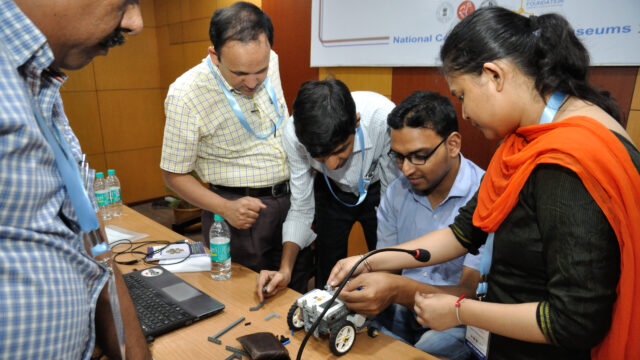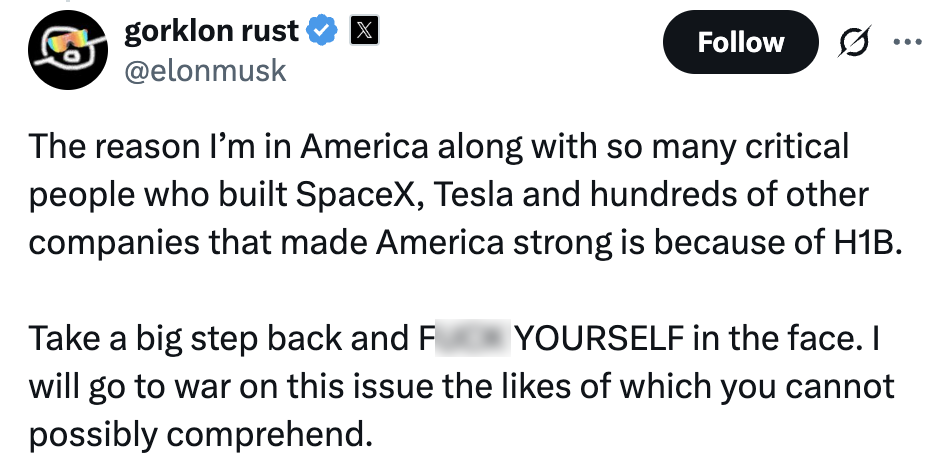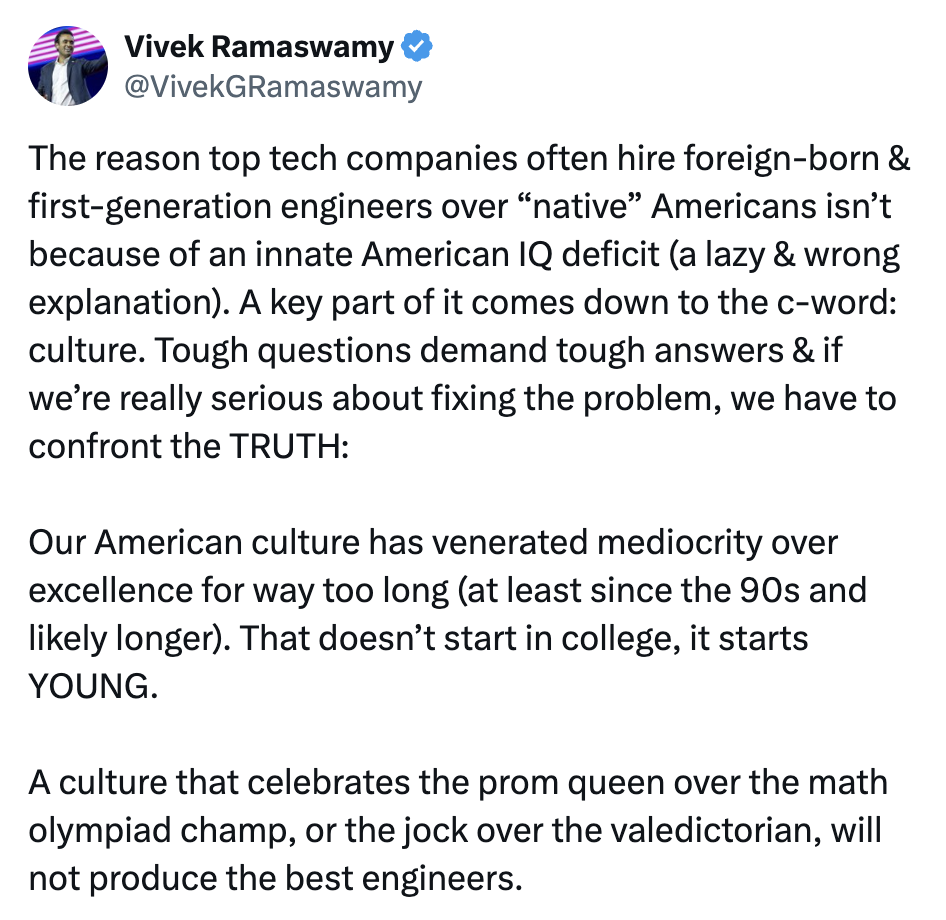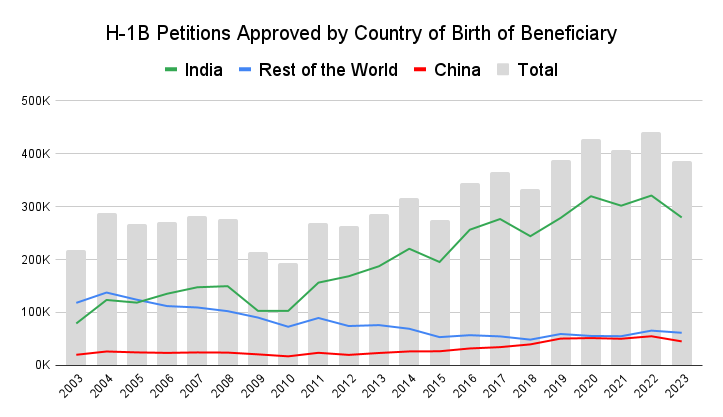Dispossessing America, Again

Tech elites are now replacing another class of American workers; instead of offshoring factories, they are onshoring low-wage Indian immigrants.
“Tamil power in the White House!” Alok Sama, ex-Softbank president, gushed with ethnic triumphalism when Sriram Krishnan was named AI policy advisor to President Trump. Krishnan is a Silicon Valley operative whose self-admitted chief concern is increasing guest worker visas and removing green card caps to “unlock” immigration from his “home” country of India. His inclusion in an administration that has vowed to prioritize American workers sparked a furor from Trump supporters, who were promptly vilified by Vivek Ramaswamy and Elon Musk on Twitter/X as racist xenophobes.
The ensuing battle unwittingly expanded the Overton Window on immigration—even if Conservatism Inc. pretends otherwise. Boomer-driven bipartisan consensus on the absolute good of legal immigration had precluded any scrutiny of its abuse, which has been escalating since the 2000s. This willful blindness has provided political cover for a second cycle of systematic wealth extraction and transfer away from the American people, this time from white-collar workers.
Beginning in the 1990s, deindustrialization stripped the nation’s manufacturing might and its attendant prosperity, gutting working-class communities while turning China into a peer competitor. Offshoring sent factory jobs overseas. “Temporary” skilled worker programs such as H-1B and L-1 visas bring foreign workers directly into American offices, laboratories, and executive suites, outsourcing science, technology, engineering, and mathematics (STEM) at home. At least the People’s Republic is on the other side of the world. The current cycle dispossesses native-born professionals of their livelihoods in their own communities, supplanting them with a permanent low-wage workforce primarily drawn from India.
Between 2010 and 2020, the “Asian Indian alone” population (as identified in the United States census) ballooned by 54.7 percent to reach 4.4 million. Due to sustained high-volume immigration, Indians now constitute the largest Asian group in the nation. Deep-rooted governance failures in the world’s most populous country of 1.43 billion, including endemic corruption, weak rule of law, and poor public infrastructure, will continue to drive large-scale emigration.
Individual Indians seeking better living conditions are not to blame. Rather, the fault lies with the American elite. Post-World War II socioeconomic forces (and arguably moral rot) turned them into rapacious plutocrats whose allegiance turned to global capital. They began to amass trillions by dismantling the nation’s industrial base and auctioning off its resources and sovereignty to the highest bidder. Then came the Internet revolution, opening the door to untold riches.
These post-national American elites sought to maximize profits by importing a foreign workforce that would cost less and lack bargaining power. Industry leaders and other stakeholders pushed unsubstantiated claims of critical labor shortages in spite of an abundance of qualified STEM professionals. Successful lobbying led to the U.S. Immigration Act of 1990, which created the H-1B visa for temporary skilled workers and Optional Practical Training (OPT) program for international students. That America must recruit the world’s “best and brightest” became a well-worn pretext.
These policies particularly advantaged Brahmins and other upper-caste Hindus in India, who have held a historical monopoly over the learned professions and were the prime beneficiaries of colonial English-language education. Lacking family wealth or political connections, they often struggled to convert their educational privilege into financial success in India’s heavily regulated socialist economy. The new visa system provided an escape and alternative path to wealth creation for this historically privileged class (to which my maternal grandparents belonged). They needed America, not the other way around.

(X.com)
“We just wanted our microwave ovens and color TVs,” Sama, the transnational banker, confessed in The Times of India. (Since leaving Softbank in 2019, Sama has assumed the role of an elite spokesperson for Indian immigration, seeking to influence public discourse and U.S. policy through his writings).
The initial flow of Indian immigrants became a deluge when backroom deals with the Bush Senior and Obama administrations increased H-1B caps, allowed indefinite visa extensions, and expanded OPT to a three-year work authorization for foreign STEM graduates. The last measure effectively turned OPT into a new guest worker pipeline without the annual cap or minimum salary requirements of the H-1B program.
When the floodgates to America opened, Indian IT staffing agencies such as Cognizant, Tata Consultancy Services, and Infosys began exploiting labor and regulatory loopholes to corner the market. Gaming the system is the sine qua non of low-trust societies, where arbitrary and oppressive laws encourage rule-breaking over compliance. As a consequence, taking advantage of unethical and illegal workarounds (known as jugaad in India) is regarded as a sign of resourcefulness, rather than immorality. When this ethos met the deliberately lax U.S. regulatory regime and its lucrative incentives, widespread fraud was the predictable result. Consequently, tactics such as bulk applications, falsified resumes, and misclassifying entry-level positions as specialty roles (to circumvent the minimum salary requirements) are used to secure a disproportionate share of work visas for Indian nationals.
In 2022, 73 percent of H-1B visa recipients were Indians. Does any one nationality comprise three-quarters of the world’s top talent? Yes, according to Ramaswamy, who insists that Indians are overrepresented in Silicon Valley because of their cultural superiority. In a tweet on X that is widely thought to have sabotaged his plans to join the Trump administration, Ramaswamy said that a social preference for “jocks and prom queens over nerds” has rendered heritage Americans too lazy and anti-intellectual to achieve the STEM excellence of Indians and other immigrants. His pop sociology critique conveniently omits India’s often literal deification of Bollywood/South Indian movie stars and cricketers. So deep is the latter obsession that India-born tech CEOs including Satya Nadella (of Microsoft) and Shantanu Narayen (of Adobe), raised $120 million to expand professional cricket in the U.S.
Lest we forget, heritage American scientists and engineers transformed sleepy agricultural towns into the heart of Silicon Valley. They pioneered the technologies behind transistors, semiconductors, integrated circuits, programming languages, microprocessors, personal computers, cellular networks, the Internet, mobile technology, and social media. Though foreign-born talent has historically contributed, no constant flow of imported workers was needed to establish America’s global hegemony in technology.
A biotech billionaire, Ramaswamy derides displaced U.S. workers for “wallowing in victimhood” and seeking legislative redress, all while ignoring clear evidence of a rigged labor market. In 2023, 9.7 million U.S. residents (native-born and immigrant) with STEM degrees worked in non-STEM jobs, and an additional 2.2 million STEM graduates were unemployed. Despite such an oversaturated labor market, 868,000 H-1B applications were approved in 2024. This figure is nearly ten times the annual statutory limit. A record 97,556 Indian students also obtained OPT work permits, up 40 percent from the previous year.

The steady supply of H-1B and OPT workers, who depend on employer sponsorship or work authorization to remain in the U.S., enables companies to pay salaries below the standard rate for native-born Americans. Sixty percent of H-1B jobs pay significantly below the local median wage, driving down salaries across the industry and thus displacing domestic professionals. Due to the surplus of visa-dependent workers legally bound to accept lower wages, overall inflation-adjusted compensation has been stagnant for the last 15 years. Since 2019, however, STEM wages have declined by 7.6 percent and benefits have decreased by 6.2 percent.
Clearly, these visas function as subsidies to reduce corporate labor costs, benefiting major H-1B employers such as Google, Microsoft, Apple, Facebook, and Tesla. This explains Musk’s vow to “wage war” against H-1B critics; his electric car company cannot afford to lose access to its cheap labor supply. Pathologizing dissent, Musk condemns Americans who resist career loss and downward mobility as “unrepentant racists” and “contemptible fools,” embittered by their looming obsolescence. They deserve to be replaced by the supposed winners of natural selection from the global talent pool—in other words, his compliant foreign workforce. To reinforce this narrative, the multi-billionaire misrepresents his own immigration path from South Africa via Canada as an H-1B success.
While the H-1B visa is central to STEM labor arbitrage, its regulatory constraints have led companies to manipulate other guest worker programs into low-cost labor pipelines. Originally intended for high-level executives on short-term assignments, the L-1 visa is easier to abuse, as it imposes no annual cap or minimum pay requirements. Foreign workers are willing to accept lower salaries because the L-1 category offers a faster path to permanent residency and allows spouses to work freely. Since 2000, Indians have received the highest number of L-1 visas annually, including 76,988 in 2019, along with 14,000 work permits for spouses. The recent opening of Google’s fourth and largest campus in India, no doubt, broadens the scope for L-1 exploitation.
Illegally employing Indians on B-1 visas (meant for brief business-related visits) in H-1B jobs forms yet another long-running scam. Infosys was slapped with a record $34 million fine for this offense, while Mu Sigma paid $2.5 million in damages. The sheer extent of visa abuse underscores the futility of incremental changes, leaving abolition and a hard reset as the only tenable solutions.
To be clear, the argument isn’t whether individual visa holders add value. Rather, the system itself has been hijacked at scale for labor arbitrage, gutting the domestic STEM pool and creating an artificial and dangerous dependence on foreign workers. A 2021 Institute of Labor Economics study shows that the 1990 immigration law has pushed U.S.-born white male STEM graduates out of STEM occupations, pushed white female STEM graduates out of the workforce, and discouraged black males from pursuing STEM majors altogether.
This systematic displacement of native-born professionals finds ideological cover in the mythologizing of Indian prowess. It explains away their “embarrassing” dominance in STEM (to quote Sama), drawing on diversity, equity, and inclusion (DEI) politics and “nation of immigrants” moralism to avert criticism.
In 2019, foreign-born workers comprised 65 percent of computer and mathematical roles and 61 percent of engineers in just two counties of Silicon Valley. Thirty years earlier, only 30 percent of the entire region’s technology workforce was born abroad. A key study by Doran, Gelber, and Isen (2022) found that one additional H-1B visa crowds out 1.5 U.S.-born workers, with no measurable improvement in innovation, productivity, or firm growth. While it has failed to spur cutting-edge progress, this labor importation model is transforming economic and electoral power structures in ways that the American people are not meant to notice.
Approximately 5.2 million people of Indian origin (identified as “Asian Indian alone or in any combination”) reside in the U.S., of whom a staggering 45 percent arrived after 2010. It is crucial to note that this migration wave is not Ellis Island 2.0. H-1B and L-1 are nonimmigrant visas with six-year and five-to-seven-year limits respectively. Yet, these categories allow visa holders to apply for permanent residency. While many nationalities pursue this option, Indians constitute the majority of applicants, creating a backlog of 1.2 million with a current processing time of 80 to 100 years. As a result, most remain in the U.S. indefinitely without officially gaining permanent residency.
These nominally temporary workers build careers, buy homes, and bring over spouses. In 2023, 186,748 visas were issued for H1-B spouses and dependents. Once the U.S.-born children of visa holders—who gain automatic citizenship—reach age 21, they can sponsor their parents and other family members through chain migration. In Indian public discourse, this well-trodden path is called the “American Dream for Indians.”

Not all systemic abuse lies in the gray zone. The long green-card waiting process has encouraged illegal workarounds. Tech influencer Debarghya “Deedy” Das used scientific fraud to fast-track his green card application through a less-crowded visa category. He has since advised others on how to do the same. On a podcast with Krishnan, he also encouraged Indians to “just marry” U.S. citizens to acquire permanent residency. Others simply overstay their visas. As of 2022, Indians were the third-largest group of illegal aliens, with a population of 725,000. (Needless to say, visa recipients do not universally engage in illegal activity.)
Given that almost one in every two Indians in the U.S. arrived within the last 15 years, it follows that they maintain strong ties to their native country. However, as Carnegie Endowment data shows, the broader demographic also regards India as its homeland, remaining “deeply connected” regardless of citizenship or years lived in America. Prevailing, albeit not universal, attitudes toward America’s majority population offer clues to this persistent distance and resulting assimilation failure.
A 2020 Carnegie Endowment survey found that 46 percent of Indian American respondents perceived Republicans as racist and overly influenced by Christian evangelicalism. Four years later, 34 percent of survey participants still saw the GOP as essentially too white and Christian, while an additional 18 percent rejected the party for its stance on abortion access. Notably, 73 percent claimed that white nationalism poses a threat to American democracy. These views are based on differences in core identity and hence cannot merely be attributed to the Republican Party’s fraught optics in the mainstream media.
Nor can they be explained as an objection to majority power. Among the Hindu respondents (the largest religious group among Indians in the U.S.), 60 percent do not consider the rise of Hindu nationalism a threat to Christians and other minorities in India. A majority approves of Prime Minister Narendra Modi, in spite of Indian democracy’s soft pivot to Hindu majoritarian rule under his government.
Indian Americans, particularly Hindus, hold overall conservative views on immigration and affirmative action within India, but predominantly adopt progressive positions on similar issues within the U.S. Supporting India’s traditional social order sustains their longstanding dominance within India, whereas Western left-wing ideology advocates for ever-increasing immigration and the rejection of assimilation, which advances their interests within America. Consequently, even with the prevalence of traditional family practices and fiscal conservatism, Indian Americans vote for Democrats by a wide margin.
In the 2024 election, 2.6 million Indian Americans were eligible to vote with 69 percent of registered voters supporting Kamala Harris, 25 percent backing Trump, and the remainder choosing a third-party candidate. These findings controvert the Bush-era claim that Asian groups are “natural conservatives” and should permanently disabuse Republicans of the illusion that they can win over this demographic en masse.
Contradictory political positions in India and the U.S. enable Indian Americans to make the most of each context. Beyond voting patterns, group interest maximization is evident in organized efforts to expand and consolidate Indian influence in American STEM. Numerous lawsuits provide evidence of institutionalized discrimination against qualified white, black, and Hispanic Americans in Silicon Valley. Indian-run firms and U.S. companies, where Indians hold hiring power, have been implicated in preferring in-group candidates and masking favoritism with inflated or fraudulent credentials. The IT outsourcing company Cognizant, the largest H-1B sponsor over the last 15 years, was found liable for racial discrimination against over 2,000 non-Indian employees between 2013 and 2022.
These cases further reveal how Americans face targeted career obstruction and workplace humiliation, including exclusion from key projects, denial of deserved promotions, and replacement by less-qualified in-group hires. However, identity politics confers Indians with moral immunity against charges of hoarding opportunity and marginalizing native-born workers. It does so by laundering historic Indian caste and class advantages into alleged racial disadvantage in America.
Tech executive Vivek Wadhwa, who arrived as a “low-level computer programmer,” describes how Indian immigrants formed co-ethnic networks to edge out the “largely white in complexion” workforce. His account of this in Inc. Magazine, titled “How the Indians Conquered Silicon Valley,” debunks the myth of meritocracy by showing that strategic gatekeeping and in-group monopolization (“social closure”) have led to institutional capture. He advocates for replicating this model in his public commentary and at mentoring events hosted by the National Association of Software and Services Companies (NASSCOM), a powerful lobby based in New Delhi.
Indian IT industry groups use congressional lobbying, litigation, and mass media campaigns to maintain high-volume immigration. Journalist Lee Fang uncovered how NASSCOM covertly recruited prominent Republicans to influence the White House. Meanwhile, ITServe Alliance successfully litigated against the Trump administration’s rule hiking wage requirements for H-1B visas. The trade association bragged about subverting U.S. labor and immigration policy in a since-deleted statement: “Have we not taken the bull by the horn, it would have resulted in mass layoffs [sic].”
No wonder professional Republicans balk at any reform with real teeth. As the theme song of The Apprentice eloquently puts it, “Money, money, money, money, money.” The Modi government actively endorses this massive influence-peddling operation, recognizing the strategic and economic value of India’s extensive diaspora in American STEM. In 2023, India received $120 billion in remittances with the U.S. as the largest contributor.
Because the economic disruption and permanent demographic change caused by legal Indian immigration are occurring without democratic consent, their success depends on the passive resignation of the American people.
A confluence of structural and ideological factors has granted India a de facto “most favored nation” immigration status, at the expense of U.S. professionals. Because the economic disruption and permanent demographic change caused by legal Indian immigration are occurring without democratic consent, their success depends on the passive resignation of the American people. Elites thus invoke rhetoric such as critical talent shortages, Indian brilliance, and native-born racism to vilify critics and legitimize transforming the nation into an economic opportunity zone and global commons.
To this end, America’s identity and social cohesion as an Anglo-Protestant culture (into which enslaved Africans and pre-Civil War and Ellis Island immigrants assimilated) must be sacrificed. While material narratives justify doing so at the neoliberal altar of GDP maximization, progressive moralism demands it as penance for the homeland’s “original sins.” The U.S. must forever remain creedal, that is, defined by abstract principles alone.
Musk proclaims the birth of this new nation thusly: “America rose to greatness over the past 150 years because it was a meritocracy more than anywhere else on Earth.” He erases the “blighted” first 250 years of American history and begins with the Second Industrial Revolution, spinning a narrative in which the modern immigrant becomes a moral savior and technology the architect of American exceptionalism.
This distorted, revisionist history has gained currency in the Indian press, social media, and policymaking circles. According to India’s Deccan Herald newspaper, the H-1B visa is a “tool and symbol” that proves foreign workers make America great. Similarly, Virginia-based lawyer Rajiv Khanna declared on a popular YouTube channel for aspiring Indian immigrants, “This country will come to a standstill if all immigrants leave. Without us, America doesn’t have a leg to stand on.”
Khanna then boasted about confronting a U.S. congressman at a televised forum. “First, I’ll help you pack your bags,” he snapped when the lawmaker raised concerns about the surging foreign workforce. “You may have been here for 100 or 150 years before me, but you are not a son of the soil. The only natives here are the ones you put in reservations. So, don’t talk to me about immigration.” Such rhetoric is meant to strip heritage Americans of moral legitimacy, reducing them to squatters in a nation forged by their forebears.
President Trump’s historic victory arose from his advocacy for the forgotten men and women, whose livelihoods have been devastated by unjust globalization. The 2024 election gave him an unequivocal mandate to overhaul immigration and codify America First principles into law. This administration has a generational opportunity to reclaim the American Dream for Americans. However, it must first overcome the vested interests within and the many circling hyenas without.
The danger is that reclaiming STEM fields for native-born Americans may only become politically viable some 25 years after irreparable damage is done, much like reindustrialization. Perhaps, it will take another extraordinary political figure, one who has been a victim of the oligarchic Big Tech and Indian immigration system, to recognize that this cycle of dispossession is above all about power. Perhaps only someone who has borne the human cost exacted by a technocratic dystopia will have the will to treat the degradation of American STEM as an urgent civilizational crisis—and enact full measures.
https://chroniclesmagazine.org/society-culture/dispossessing-america-again/
